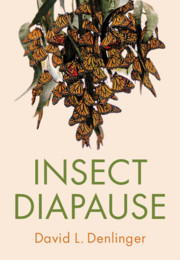Book contents
- Insect Diapause
- Insect Diapause
- Copyright page
- Dedication
- Contents
- Preface
- 1 Confronting the Challenges of a Seasonal Environment
- 2 Which Seasons Are Being Avoided?
- 3 Variation in the Diapause Response
- 4 The Cost of Diapause and Some Diapause Alternatives
- 5 Interpreting Seasonal Cues to Program Diapause Entry
- 6 Preparing for Diapause
- 7 The Diapause State
- 8 Ending Diapause and Reinitiating Development
- 9 Molecular Signaling Pathways that Regulate Diapause
- 10 Genetic Control of Diapause
- 11 Evolution of Diapause
- 12 Wider Implications
- References
- Species Index
- Subject Index
- Plate Section (PDF Only)
11 - Evolution of Diapause
Published online by Cambridge University Press: 13 January 2022
- Insect Diapause
- Insect Diapause
- Copyright page
- Dedication
- Contents
- Preface
- 1 Confronting the Challenges of a Seasonal Environment
- 2 Which Seasons Are Being Avoided?
- 3 Variation in the Diapause Response
- 4 The Cost of Diapause and Some Diapause Alternatives
- 5 Interpreting Seasonal Cues to Program Diapause Entry
- 6 Preparing for Diapause
- 7 The Diapause State
- 8 Ending Diapause and Reinitiating Development
- 9 Molecular Signaling Pathways that Regulate Diapause
- 10 Genetic Control of Diapause
- 11 Evolution of Diapause
- 12 Wider Implications
- References
- Species Index
- Subject Index
- Plate Section (PDF Only)
Summary
Three questions are addressed here. How did diapause arise? How did evolution shape the diapause response in time and space? And, how did diapause impact evolution of insect sociality? Insect development is a progression of starts and stops. This sets the stage for exploiting the stop points for insertion of a period of developmental arrest. Integration of a photoperiodic clock mechanism with developmental regulation likely leads to the precise developmental timing that is essential for diapause. Though the diapause phenotype is shared among diverse species, the same endpoint (diapause) can be attained using different molecular tools, suggesting that insect diapause has arisen numerous times in evolutionary history. Responses along latitudinal clines and to climate change underscore the rapidity of evolutionary change that is possible. Mounting evidence supports the idea that adult diapause may have been crucial for the evolution of sociality in wasps and related Hymenoptera.
Keywords
- Type
- Chapter
- Information
- Insect Diapause , pp. 305 - 322Publisher: Cambridge University PressPrint publication year: 2022

